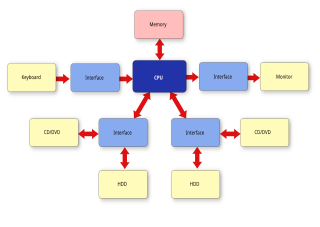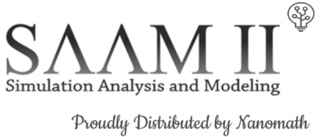
Computer-aided design (CAD) is the use of computers to aid in the creation, modification, analysis, or optimization of a design. This software is used to increase the productivity of the designer, improve the quality of design, improve communications through documentation, and to create a database for manufacturing. Designs made through CAD software help protect products and inventions when used in patent applications. CAD output is often in the form of electronic files for print, machining, or other manufacturing operations. The terms computer-aided drafting (CAD) and computer-aided design and drafting (CADD) are also used.

Software architecture is the set of structures needed to reason about a software system and the discipline of creating such structures and systems. Each structure comprises software elements, relations among them, and properties of both elements and relations.
Software design is the process of conceptualizing how a software system will work before it is implemented or modified. Software design also refers to the direct result of the design process – the concepts of how the software will work which consists of both design documentation and undocumented concepts.
The rational unified process (RUP) is an iterative software development process framework created by the Rational Software Corporation, a division of IBM since 2003. RUP is not a single concrete prescriptive process, but rather an adaptable process framework, intended to be tailored by the development organizations and software project teams that will select the elements of the process that are appropriate for their needs. RUP is a specific implementation of the Unified Process.
Software development is the process used to conceive, specify, design, program, document, test, and bug fix in order to create and maintain applications, frameworks, or other software components. Software development involves writing and maintaining the source code, but in a broader sense, it includes all processes from the conception of the desired software through the final manifestation, typically in a planned and structured process often overlapping with software engineering. Software development also includes research, new development, prototyping, modification, reuse, re-engineering, maintenance, or any other activities that result in software products.

In systems engineering and software engineering, requirements analysis focuses on the tasks that determine the needs or conditions to meet the new or altered product or project, taking account of the possibly conflicting requirements of the various stakeholders, analyzing, documenting, validating and managing software or system requirements.
A requirement is a singular documented physical or functional need that a particular design, product, or process aims to satisfy. It is commonly used in engineering design, systems engineering, software engineering, enterprise engineering, product development, and process optimization. It is a broad concept that could speak to any necessary function, attribute, capability, characteristic, or quality of a system for it to have value and utility to a customer, organization, internal user, or other stakeholder. Requirements can come with different levels of specificity; for example, a requirement specification or requirement "spec" refers to an explicit, highly objective/clear requirement to be satisfied by a material, design, product, or service.
In computer programming, a software framework is an abstraction in which software, providing generic functionality, can be selectively changed by additional user-written code, thus providing application-specific software. It provides a standard way to build and deploy applications and is a universal, reusable software environment that provides particular functionality as part of a larger software platform to facilitate the development of software applications, products and solutions.
In software engineering, architecture tradeoff analysis method (ATAM) is a risk-mitigation process used early in the software development life cycle.

A system architecture is the conceptual model that defines the structure, behavior, and more views of a system. An architecture description is a formal description and representation of a system, organized in a way that supports reasoning about the structures and behaviors of the system.
IEEE 1471 is a superseded IEEE standard for describing the architecture of a "software-intensive system", also known as software architecture.

In software engineering, structured analysis (SA) and structured design (SD) are methods for analyzing business requirements and developing specifications for converting practices into computer programs, hardware configurations, and related manual procedures.

A functional specification in systems engineering and software development is a document that specifies the functions that a system or component must perform.

A design rationale is an explicit documentation of the reasons behind decisions made when designing a system or artifact. As initially developed by W.R. Kunz and Horst Rittel, design rationale seeks to provide argumentation-based structure to the political, collaborative process of addressing wicked problems.
Service-oriented modeling is the discipline of modeling business and software systems, for the purpose of designing and specifying service-oriented business systems within a variety of architectural styles and paradigms, such as application architecture, service-oriented architecture, microservices, and cloud computing.

In systems engineering, software engineering, and computer science, a function model or functional model is a structured representation of the functions within the modeled system or subject area.
In software engineering, active reviews for intermediate designs (ARID) is a method to evaluate software architectures, especially on an intermediate level, i.e. for non-finished architectures. It combines aspects from scenario-based design review techniques, such as the architecture tradeoff analysis method (ATAM) and the software architecture analysis method (SAAM), as well as active design reviews (ADR).
Leonard Joel (Len) Bass is an American software engineer, Emeritus professor and former researcher at the Software Engineering Institute (SEI), particularly known for his contributions on software architecture in practice.

SAAM II, short for "Simulation Analysis and Modeling" version 2.0, is a renowned computer program designed for scientific research in the field of bioscience. It is a descriptive and exploratory tool in drug development, tracers, metabolic disorders, and pharmacokinetics/pharmacodynamics research. It is grounded in the principles of multi-compartment model theory, which is a widely-used approach for modeling complex biological systems. SAAM II facilitates the construction and simulation of models, providing researchers with a friendly user interface allowing the quick run and multi-fitting of simple and complex structures and data. SAAM II is used by many Pharma and Pharmacy Schools as a drug development, research, and educational tool.








